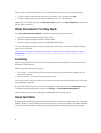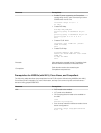
2
Installation and Quick Start
The following sections provide installation and quick start information, including step-by-step
instructions for deploying and configuring ASM in VMware vSphere or Microsoft virtualization
environment. Only one instance of ASM should be installed within a network environment. Exceeding this
limit can cause conflicts in device communication.
Information Prerequisites
Before you begin the installation process:
• Gather TCP/IP address information to assign to the virtual appliance.
• Deploying the ASM virtual appliance to a VMware vSphere environment requires that both VMware
vCenter Server and VMware vSphere Client be running.
• Deploying the ASM virtual appliance to a Microsoft Windows virtualization environment requires that
the hyper-v host on which ASM will be deployed is installed on a running instance of SCVMM..
• Download ASM appliance file, which contains either the virtual appliance .ovf file for (VMware) or the
virtual appliance virtual hard drive .vhd (Hyper-V).
• Determine the host on which the ASM virtual appliance will be installed. You can use any host
managed by VMware vCenter or Hyper-V manager that has network connectivity with your out-of-
band (OOB), management, and potentially iSCSI networks. This is required for discovery to complete
successfully.
CAUTION: ASM virtual appliance functions as a regular virtual machine. Therefore, any
interruptions or shut downs affects the overall functionality.
Installing Active System Manger
Before you begin, make sure that systems are connected and VMware vCenter Server, VMware vSphere
Client, and SCVMM are running.
Deployment Prerequisites
Specification Prerequisite
Connection Requirements
• The virtual appliance is able to communicate
with the out-of-band management network
and any other networks from which you want
to discover the resources.
8


















